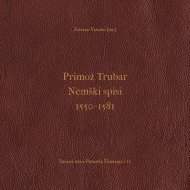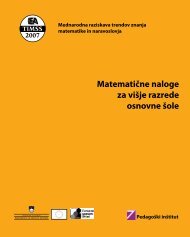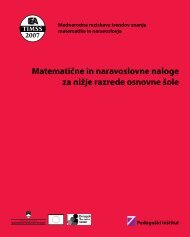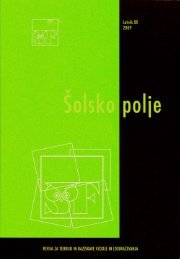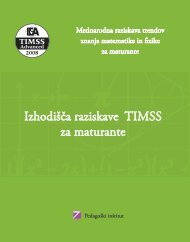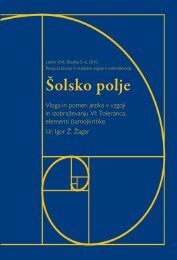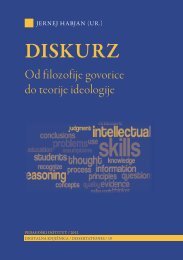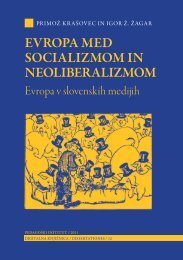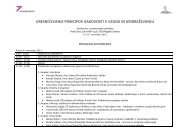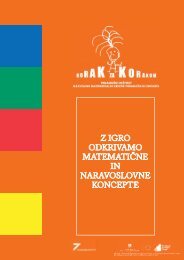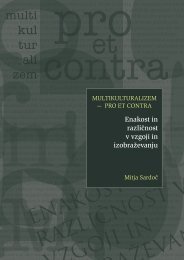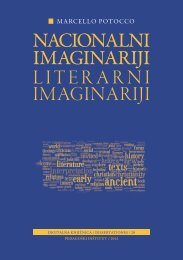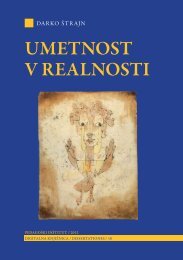Šolsko polje, letnik XX, številka 5-6, 2009: Vloga ... - Pedagoški inštitut
Šolsko polje, letnik XX, številka 5-6, 2009: Vloga ... - Pedagoški inštitut
Šolsko polje, letnik XX, številka 5-6, 2009: Vloga ... - Pedagoški inštitut
You also want an ePaper? Increase the reach of your titles
YUMPU automatically turns print PDFs into web optimized ePapers that Google loves.
76 ŠOLSKO POLJE LETNIK <strong>XX</strong> ŠTEVILKA 5/6poems full of nostalgic sentiments for Greater Serbia. 2 In his own poetry,the butchery he had led against »the Turks«– Bosnian Muslims – wasopenly expressed. 3 As Čolović (2002) points out, »exile, destruction, death,and return to a forsaken homeland« as well as »hatred« are themes thatcommonly feature in his works and actions. The titles of his poems areillustrative here: Goodbye, Assassins, A Man Made of Ashes, and War Boots.Čolović (2002: 34) calls Karadžić’s poetry »war-propaganda folklore« thattransfers »conflicts from the sphere of politics, economy and history intothe extrapolated sphere of myth.« The role of poets in the war of the 1990sin the former Yugoslavia has led Slavoj Žižek to famously declare that»instead of the military-industrial complex, we in post-Yugoslavia had themilitary-poetic complex personified in the twin figures of Ratko Mladićand Radovan Karadžić« (Žižek, 2008: 17). This article explores the waysin which TS’s journalists covered Karadžić’s arrest, arguing that it complementedthe aestheticization of politics enacted by his poetry. In thisregard, we might supplement Žižek’s account by noting the way in whichthe forms of forgetting, idealization, and nostalgia that characterized nationalistpoetry were reproduced for mass audiences by the electronicmedia, creating a military-poetic-media-entertainment complex.The first part of this paper introduces some historical frameworks andtheoretical investigations. We briefly deal with Boym’s »reflective« and »restorative«definitions of nostalgia – she distinguishes between two narrativesof nostalgia that frame feelings of dislocation differently, since they both tryto understand how we relate to a collective home (41). In the second part,we present a study which uncovers how TS’s journalists exploit and furtherincorporate a particular social event (in our case, Karadžić’s arrest) into nationalisticand a »restorative nostalgic« discourse. The research is based on criticaldiscourse analysis (the analysis of recontextualization and the analysisof representation of social actors) (Fairclough, 1992; Van Leeuwen, 1996;Wodak, 1996, 2006). We argue that TS, while covering Karadžić’s arrest, constructeda nationalistic discourse that invoked nostalgia for the prospect ofthe creation of Greater Serbia. Any connections between Karadžić, the Serbs,and especially the current government with war crimes in BH were brushedaside. This nostalgia for Greater Serbia, we argue, exemplifies a political paradoxin Serbia: at the same time that information on the historical atrocities ofthe former Yugoslav regimes and of Serbia’s role in these atrocities was beingmade available to the Serbian public, nostalgia for selected cultural aspects ofthe Serbian past is growing as well. The conclusions offer some observationsdirected towards answering how to refine theories of memory, nostalgia, and



